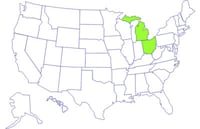As Americans go into the 4th of July weekend, they will not be getting a break. Fear the hamburger. Pass on the tomatoes. Fireworks, but better skip the salsa. We are experiencing another year just like the last one, awash in food-borne illness.
Last year was so obvious. Topps was reeking in E. coli O157:H7. There was undercover video tape of the Chino slaughterhouse. This year, there is mystery. More than usual. The rare Salmonella Saintpaul has had its way with America for six weeks leaving our blue-chip food safety agencies without a clue as to where its coming from.
About the 4th of July, John Adams said: "It ought to be solemnized with Pomp and Parade, with Shews, Games, Sports, Guns, Bells, Bonfires and Illuminations from one End of this Continent to the other from this Time forward forever more." Kroger customers who are recovering from E. coli O157:H7 probably won’t feel much like celebrating.
Maybe those good folks will spend time contemplating why the near 2,500-store Kroger chain is still buying from the notorious Nebraska Beef Ltd. You would think Kroger would have a sufficient sense of corporate responsibility to check out the background of its beef suppliers.
From the Centers for Disease Control & Prevention (CDC), here’s the latest on the nation-wide Salmonella Saintpaul and Michigan/Ohio E. coli outbreaks.
SALMONELLA SAINTPAUL
Since April, 869 persons infected with Salmonella Saintpaul with the same genetic fingerprint have been identified in 36 states and the District of Columbia. These were identified because clinical laboratories in all states send Salmonella strains from ill persons to their State public health laboratory for characterization.
The number of ill persons identified in each state is as follows: Arkansas (10 persons), Arizona (41), California (10), Colorado (11), Connecticut (4), Florida (1), Georgia (20), Idaho (3), Illinois (91), Indiana (11), Kansas (14), Kentucky (1), Maine (1), Maryland (29), Massachusetts (21), Michigan (6), Minnesota (2), Missouri (12), New Hampshire (3), Nevada (11), New Jersey (6), New Mexico (90), New York (26), North Carolina (5), Ohio (7), Oklahoma (23), Oregon (10), Pennsylvania (8), Rhode Island (3), Tennessee (6), Texas (346), Utah (2), Virginia (22), Vermont (2), Washington (4), Wisconsin (6), and the District of Columbia (1).
Among the 588 persons with information available, illnesses began between April 10 and June 20, 2008, including 179 who became ill on June 1 or later. Many steps must occur between a person becoming ill and the determination that the illness was caused by the outbreak strain of Salmonella; these steps take an average of 2-3 weeks.
Therefore, an illness reported today may have begun 2-3 weeks ago. Patients range in age from <1 to 99 years; 48 percent are female. The rate of illness is highest among persons 20 to 29 years old; the rate of illness is lowest in children 10 to 19 years old and in persons greater than 80 years old. At least 107 persons were hospitalized.
No deaths have been officially attributed to this outbreak. However, a man in his sixties who died in Texas from cancer had an infection with the outbreak strain of Salmonella Saintpaul at the time of his death. The infection may have contributed to his death.
Only 3 persons infected with this strain of Salmonella Saintpaul were identified in the country during the same period in 2007
E. COLI O157:H7
We will continue with information on the E. coli O157:H7 outbreak involving Kroger and Nebraska Beef in the extended reading section.
State departments of health and agriculture in Michigan and Ohio, collaborating local health jurisdictions, CDC, and the United States Department of Agriculture’s Food Safety and Inspection Service (USDA-FSIS) are investigating a multi-state outbreak of Escherichia coli O157:H7 infections.
States with cases of E. coli 0157:H7 infections with the outbreak strain

Based on this investigation, as of 5pm EST, June 30, 2008, 38 confirmed cases have been linked both epidemiologically and by molecular fingerprinting to this outbreak, 20 in Michigan and 18 in Ohio. Onset of illness in these patients occurred from 5/30/08 to 6/18/08.
Nineteen ill persons have been hospitalized. One patient has developed a type of kidney failure called hemolytic-uremic syndrome (HUS). No deaths linked to the outbreak have been reported. Twenty-three (61%) of patients are female. Patients range in age from 4 to 78 years with a median age of 19 years.
CDC and public health agencies across the United States continue surveillance activities to detect additional cases related to this outbreak.
State health and agriculture departments have tested ground beef recovered from patient residences and purchased at Kroger® retail stores in Michigan and Ohio.
Molecular fingerprinting testing conducted by the Ohio and Michigan Departments of Health and Agriculture Laboratories, in collaboration with PulseNet, the national molecular subtyping network for foodborne disease surveillance, on E. coli O157 isolates isolated from these ground beef samples have confirmed the isolates to be the outbreak strain of E. coli O157.
Source: CDC